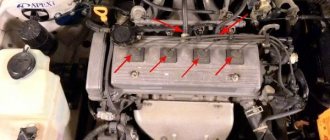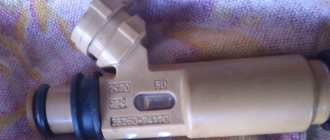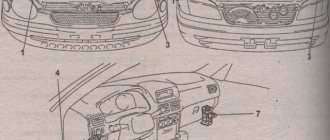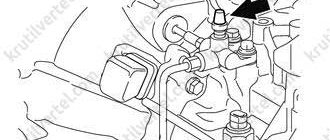Bleeding the brakes on a Toyota with ABS is not much more difficult than on its standard version. To remove air from the braking system of a car that has ABS, you should understand how it works specifically for your model. The reason for this need is that depending on the model, the circuit may have some differences.
For example, if the hydraulic valve block and the hydraulic accumulator with the pump are located in the same block, then the procedure for bleeding the brakes will be similar to its implementation on a regular car where there is no ABS system.
Features of bleeding brakes with ABS
Bleeding the brakes should be carried out together with a partner, one presses the brake pedal and monitors the level of brake fluid in the reservoir, the second carries out bleeding by bleeding the brake fluid through the wheel bleeder fitting.
Bleeding begins with the wheel that has the longest main brake pipe, for me it is the rear right, then the rear left, the front right and the front left.
The peculiarity of bleeding the brake system with ABS is that it is carried out in the same way as usual, only with the engine running.
General principle of pumping
The actions are performed in this order:
- Find and remove the fuse in the block responsible for ABS operation;
- Unscrew the wheel and find the RTC fitting, which is responsible for bleeding the brakes;
- Start bleeding the ABS brakes with the pedal depressed;
- Turn on the hydraulic pump, as indicated by the ABS lamp lighting up on the instrument panel, and wait until the air is completely released;
- Tighten the fitting and release the brake pedal. If the ABS light goes out, then everything was done correctly and all the air has escaped.
More: Should you flush the engine before changing the oil?
Brake bleeding process
The vinyl tube of our device is connected to the wheel bleeder fitting, a 10mm wrench is prepared to unscrew the fitting (you can first use a 10mm wrench to loosen the fitting so as not to tear off the edges).
Press the brake pedal several times, then keep the pedal pressed and loosen the fitting; when the brake fluid stops leaking, the fitting is tightened and the procedure is repeated until air bubbles stop appearing.
The brake fluid level in the reservoir is periodically checked and topped up if necessary.
The bleeding procedure is carried out for each wheel.
Instructions for replacing brake fluid
If you don’t want to waste your personal time and are not afraid of the cost of performing this operation (from 800 rubles), then you should go to the nearest service station. But you need to understand that every car enthusiast with hands can replace the brake fluid on a Prado 150 diesel.
The algorithm for carrying out this work is as follows:
- Using a medical bulb, remove the brake fluid in the reservoir. In this case, a small part of it should be left at the bottom to prevent air from entering the system. A layer of no more than ten millimeters is left.
- Add new consumables to the compensation tank to the level marked MAX.
- With all possible care to prevent curling, open the fitting designed to remove air. To facilitate this action, it should be pre-treated (2 hours before) with a rust remover. If after taking the steps you cannot unscrew the fitting, you will have to go to a service station.
- Having gained access to the rear caliper on the disc wheel mechanism, we put one end of the hose on the air bleeder fitting. It must be clean and transparent. To place the second end, use any container, for example, a plastic bottle.
- An assistant should be asked to press the brake pedal until a feeling of resistance to pressing appears in the leg. Having depressed the pedal, it is held in this position, while opening the fitting. When the pedal falls down and hits the floor of the body, the air outlet is blocked. The procedure is repeated until no more bubbles appear in the transparent hose. During its execution, as a rule, about 0.5 liters of liquid are pumped out.
- We finally close the fitting and fill the compensation tank with new DOT 5.1.
- The same scheme is used to bleed all calipers or working brake cylinders.
- To dispose of old brake fluid, you should contact special points that accept used fuel and lubricants.
- To check the free play of the pedal, you need to press it. It should not move more than 1/3 of the full stroke.
- DOT 5.1. is poured into the tank to the required level, after which it is closed.
- To confirm reliability, the following steps are taken:
- the quality of fastening of hoses and pipelines is checked;
- The tightening of air bleed fittings is inspected.
- We start the diesel and make sure the system is tight. To do this, press the brake pedal 10-15 times with a force corresponding to 20-30 kilograms. In this case, the pedal should not move back. Once again, all connections are checked for leaks.
- The final test is carried out while driving on the road with intensive changes in acceleration and braking modes. The effect of ABS is confirmed by the pulsation of the brake pedal when you press it.
For those who still have questions about replacing brake fluid on a Toyota Prado 150, we recommend watching the video.
The brake system of the Land Cruiser 200
The brake system (hereinafter - TS) of the Land Cruiser 200 is no different from the device in cars of the same class. Its components: pads, discs, calipers.
The purpose of the pads is to reduce the speed of the car. The safety of the brake discs is important. The Land Cruiser 200 has special pads made of high-strength materials.
The peculiarity of the disks on the LK 200 is that they are floating. Thanks to this, the car is protected from slipping and skidding when the car needs to be stopped.
The calipers have 8 pistons.
The vehicle in the LC 200 is controlled by electronics, the operation of which is oriented by the on-board computer. He, in turn, takes data from the brake pedal.
Due to the precise operation of the electronics and mechanical parts, the car has a reliable vehicle that is guaranteed to work even in the most critical situations.
What brake fluid to use for Land Cruiser Prado
Since Toyota has an intelligent ABS system, it is recommended to fill the reservoir with DOT 5.1. This requirement is explained by the fact that the operating principle of ABS allows it to recognize the percentage of slipping and take its own measures to reduce it, thereby reducing the duration of braking. And additional overloads imply the use of materials with a certain viscosity.
However, if we look at the manual, we will see that it is possible to use DOT3 or DOT4. A prerequisite for this is confirmation of their compliance with international standards SAE J1703 and SAE J1704.
Bleeding the hydraulic brake system
Bleeding the hydraulic brake system should be carried out by professional car service specialists. However, you can do this yourself.
The first thing to remember is that TJ is poisonous. When working with it, you must observe safety precautions. Use only the recommended type of liquid and pour only from a new sealed container.
To bleed the brakes on a Toyota Land Cruiser 200, you will need the help of a second person.
- Disconnect the ground terminal from the battery to disable the ABS system while bleeding.
- Place the pre-prepared rubber tube onto the bleeder fitting. Dip its other end into a glass container with the prepared liquid.
- During bleeding, it is important to ensure that the fluid level in the master cylinder does not fall below o.
- While in the car, the second person must press the brake pedal several times and then hold it down.
- The first person opens the fitting with his hand and makes sure that liquid stops flowing from it. After this, the second person smoothly releases the gas pedal. The first checks the level in the master cylinder.
- This process continues until the bubbles leave the escaping liquid. On average, the procedure is carried out 5-6 times.
- The fitting is tightened and a cap is put on it.
- The process is repeated for each wheel.
It is important that the car is on a flat, horizontal surface during the procedure.
After bleeding the Land Cruiser 200 brakes, you need to remove the spilled fuel fluid and check the level in the master cylinder. Discard the drained solution - it is not suitable for reuse. Before driving, check the brake pedal. If, after repeated pressing, it does not become elastic, the procedure should be repeated, because the air has not been completely bled out.
Read more: UAZ 396294 fuel consumption standards
The scheme for bleeding the brakes on the Land Cruiser 80 and the method for bleeding the brakes on the Land Cruiser 100 are generally similar.
What is special about the brake part?
Many people wonder why the brake system is so special? After all, there are other components in the car, without which you cannot go out on the road and feel comfortable. All this is true, but there is one thing: if you can start and drive even with the brakes not working, then you will not be able to stop, and this is an extremely important point, isn’t it?
It follows from this that the main function of the mechanism under discussion is to reduce the speed of your Prado 120 until the car stops completely, and the operation of this unit also includes the function of holding the “iron horse” in one place. If these tasks, which are not difficult at first glance, are completed, then everything is working well, and you can hit the road without fear.
However, that’s not all, the braking system in both the 120 and many other cars is divided into several types, and we’ll talk about them in more detail.
Brake system maintenance
In order for the vehicle to function properly, it is necessary to monitor the wear of its components. This primarily concerns brake pads. Their timely replacement will help extend the life of the brake discs, which must be replaced if worn.
The second need is to regularly pump the vehicle so that it works reliably and properly in an emergency.
Replacing brake fluid
According to the manufacturer's recommendations, a complete replacement of the Land Cruiser 200 brake fluid should be carried out every 2 years. If the car is used in mountainous and wooded areas, it is changed more often.
If this is not done, the efficiency of the vehicle decreases. The fact is that TJ absorbs moisture during operation. This reduces the boiling point. This entails the process of vaporization.
To work on replacing a working fuel fluid, you must:
- a key to unscrew the air bleeder fitting;
- tube 6 mm in diameter, container for brake fluid;
- According to the technical characteristics of the Land Cruiser 200, purchase the required number of TJs.
Algorithm for performing the work:
- Remove liquid from the tank to the minimum mark (10 mm). It is impossible to completely pump out the fluid so that air does not get into the vehicle.
- Fill the compensation tank to the maximum level.
- Carefully unscrew the fitting.
- Insert one end of the hose into the fitting, the other into a container for collecting the working fluid, into which pour a small amount of TJ. The container should be 30 cm above the bleeder fitting to ensure pressure and prevent air from entering.
- With the help of a second person, pump out the old working fluid in a volume of 450 ml by squeezing the brake pedal until a new (light) fluid appears.
- Close the fitting and add new fluid to the compensation tank.
- Do the same procedure for each caliper and brake cylinder.
- Fill the master cylinder with fluid to the required level.
The drained liquid cannot be reused. It must be handed over to a collection point.
The correctness of the replacement work is checked by pressing the brake pedal several times. The pedal play should be about 30%.
It is also necessary to check the correct fastening of the hoses, the tightening of the fittings, and the level in the working fluid reservoir.
Next, start the car. Press the brake pedal a dozen times: it should not lean back.
After leaving the place of work, check the operation of the vehicle on a road with light traffic and in conditions of no road surface. You will need to brake sharply: this is how the anti-lock braking system works (the gas pedal should vibrate).
When to change brake fluid
Replacement is carried out once every 1.5 or 2 years, or after covering 30 thousand kilometers. Also, the need to change the brake fluid for the Prado 120 is determined using special testers that determine its condition.
Its boiling point is taken as the main operating characteristic of this important consumable for Prado. If this indicator is not higher than 175o, and the time has not come to fulfill the planned regulations, then this means that the time for replacement has not yet come.
A temperature range from 165° to 175° is considered borderline, which signals the imminent end of the working capacity of the substance filling the system. A drop below 165° requires an urgent replacement of the brake fluid in the engine.











